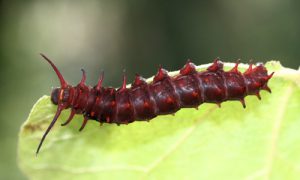Welcome back to our monthly blog in which we discuss a few interesting facts about butterflies in general and a specific type of butterfly, focusing this month on the pipevine swallowtail.
This month I want to talk about how to distinguish moths from butterflies. There are some 700 species of butterflies in North America but more than 7000 different kinds of moths! These are some of the major differences that make it fairly easy to tell them apart:
- Butterflies are active during the day and have bright colors, they bask in the sun to warm up in the morning, they fold their wings when resting, have a slender body with smooth scales on their wings and thin antennae with knobby ends.
- Moths on the other hand are generally active at night, have drab colors, shiver to increase their body temperature, rest with extended wings and have a stout body with “furry” wings and wide feathery antennae.
As usual in nature, there are exceptions to these rules, but this should make it a lot easier for you to tell the difference.
The Pipevine or Blue Swallowtail
This 2.5-4.5-inch black butterfly is easy to recognize because of the beautiful iridescent bluish green color on the hindwings of the males, edged in white spots. On the underside both sexes display a row of orange spots on the outer edges of the wings. This patterning warns birds of this butterfly’s foul taste and has been proven to even work in warning them away from similarly colored but better tasting butterfly species.
of this butterfly’s foul taste and has been proven to even work in warning them away from similarly colored but better tasting butterfly species.
They can be found in all of Florida except the very south from March through November and like to feed on milkweeds and thistle but will visit a variety of other plants.
The larvae are black, brown or red with rows of bright orange dots and use the toxic chemical in their hostplant, various species of the Pipevine, to discourage predators.
Please join us again next month when we will discuss the Painted Lady Butterfly and the symbolism of butterflies in different cultures.
symbolism of butterflies in different cultures.
For additional information please visit https://gardeningsolutions.ifas.ufl.edu/design/types-of-gardens/butterflygardens.html
Written by Carin Ashman, UF/IFAS Extension Clay County Master Gardener Volunteer
 1
1
